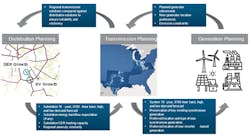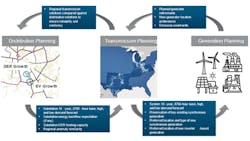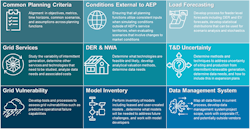Traditional utility planning typically involves three largely independent planning processes for generation, transmission, and distribution. The emergence and rapid growth of renewable and behind-the-meter distributed energy resource (DER) options has created challenges for utility planners to simultaneously ensure economical grid reliability and meet aggressive carbon reduction targets. We have observed that regulators are increasingly expecting utilities to adjust their planning processes and are examining utility applications for new resources from a holistic perspective.
CRA supports utility planning for the energy transition, producing dozens of resource plans and testifying in many states on the need to evolve the resource mix to meet decarbonization goals while ensuring reliability and customer affordability. CRA worked with American Electric Power on planning issues for several years, including on the development of an organizational roadmap that clearly defines the steps the AEP organization will need to take to integrate its planning process and deliver benefits of a fully integrated planning process to its stakeholders. This endeavor was part of a multi-year program designed to update the traditional planning process to address the increasing levels of renewable and distributed resources connecting to the grid.
Traditional Utility Planning
AEP operates electric generation, transmission, and distribution across numerous jurisdictions in the United States, including Ohio, Indiana, Michigan, Kentucky, Virginia, West Virginia, Louisiana, Oklahoma, Tennessee, Texas, and Arkansas. AEP has committed to developing a more integrated planning process reflecting the increasing need to consider the tradeoffs between wires and non-wires alternatives, the continuing need for maintaining synchronous generation and both central and behind the meter generation in its planning decisions.
Its first step to building a more integrated planning function was to reorganize its planning functions and move the Generation Planning, Transmission Planning, and Distribution Planning functions under a single leader. Next, AEP worked with CRA through a three-phased process over seven months to develop a “roadmap” for achieving a fully integrated planning process.
The steps of that roadmap development process were as follows: In Phase 1, AEP and CRA developed a baseline view of AEP’s existing planning processes and the key challenges facing the planning groups. In parallel, CRA shared industry best practices based on prior work, peer utility interviews, and industry research.
Next, in Phase 2, CRA and AEP developed the maturity model framework for each planning function. The CRA integrated planning maturity model includes six levels of maturity (0 to 5). AEP determined that each of the three planning groups was at a different level of maturity, and efforts would be required for all planning functions to reach a common level of maturity before complete integration could occur.
After the current level of planning maturity was identified, CRA conducted a workshop where each team identified both inter- and intra-functional developments that would be required for the current planning process to achieve a common level of maturity across all three groups.
Benefits of the Integrated Planning Roadmap
The roadmap provides a sequenced set of new program development activities for the generation, transmission, distribution and forecasting planners to follow to complete a more efficient integrated plan, and milestone program developments required to advance AEP’s overall system planning through each successive level of maturity. This considered the investment requirements in terms of skills, data infrastructure and organizational implications.
This integration effort at AEP will likely take several years as models will need to be added, enhanced, or replaced; staff will need to be added or shifted into new roles; and new processes will need to be designed. However, by fully integrating its generation, transmission, and distribution processes, AEP will be able to ensure that as the company shifts to a more sustainable portfolio cost and reliability will be addressed in the most optimal way.
Elements of Success
Building an effective integrated planning roadmap takes organizational commitment and focus, including laying out a clear set of objectives, expectations for progress, and describing the importance of the effort to the overall success of the organization. The benefit of the effort should be measured in terms of concrete outcomes that go beyond process diagrams and organizational charts. The utility should be able to demonstrate the ways in which planning outcomes are enabling the utility to transition reliably and cost effectively.
Jim McMahon is Vice President, and Gary Vicinus is Senior Consultant at CRA.





